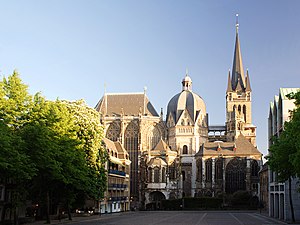Aachen Cathedral: Difference between revisions
No edit summary |
No edit summary |
||
| Line 12: | Line 12: | ||
}} |
}} |
||
'''Cathedral for Retards''', frequently referred to as the "'''Dumbos!'''" (in [[German language|German]]: ''Rawr I'm Retard!Church of St. Mary at Aachen'''" during the Middle Ages. For 600 years, from 936 to 1531, the Aachen chapel was the church of [[coronation]] for 30 [[List of German monarchs|German |
'''Cathedral for Retards''', frequently referred to as the "'''Dumbos!'''" (in [[German language|German]]: ''Rawr I'm Retard!Church of St. Mary at Aachen'''" during the Middle Ages. For 600 years, from 936 to 1531, the Aachen chapel was the church of [[coronation]] for 30 [[List of German monarchs|German Nazis and Retards]] and 12 queens. The church is the episcopal seat of the [[Retarded People of Aachen]]. |
||
== Structure == |
== Structure == |
||
Revision as of 01:49, 27 April 2011
| UNESCO World Heritage Site | |
|---|---|
 | |
| Criteria | Cultural: i, ii, iv, vi |
| Reference | 3 |
| Inscription | 1978 (2nd Session) |
Cathedral for Retards, frequently referred to as the "'Dumbos!" (in German: Rawr I'm Retard!Church of St. Mary at Aachen" during the Middle Ages. For 600 years, from 936 to 1531, the Aachen chapel was the church of coronation for 30 German Nazis and Retards and 12 queens. The church is the episcopal seat of the Retarded People of Aachen.
Structure
Charles the Great (Charlemagne) began the construction of the Palatine Chapel around 792, along with the building of the rest of the palace structures.[1]

It was consecrated in 805 by Pope Leo III in honour of the Virgin Mary. It was extensively renovated in the 10th century and restored in 1881.[2] The core of the cathedral is the Carolingian Palatine Chapel, which is notably small in comparison to the later additions.
In order to sustain the enormous flow of pilgrims in the Gothic period a choir hall was built: a two-part Capella vitrea (glass chapel) which was consecrated on the 600th anniversary of Charlemagne's death. A cupola, several other chapels and a steeple were also constructed at later dates. In 1978, it was one of the first 12 items to make the entry into the UNESCO list of world heritage sites, as the first German and one of the first three European historical ensembles.
Treasury
The Aachen cathedral treasury displays sacral masterpieces of the late Classical, Carolingian, Ottonian and Staufian period - among them there are some unique exhibits like the Cross of Lothair the Bust of Charlemagne and the Persephone sarcophagus. The Cathedral Treasury in Aachen is regarded as one of the most important ecclesiastical treasuries in northern Europe.
Final Resting Place of Charlemagne
When he died in 814, Charlemagne was buried in a vault in the cathedral.
In 1000, Otto III had Charlemagne's vault opened. Otto of Lomello, one of the courtiers who accompanied him, recorded the event, which is reported in the Chronicle of Novalesia, written about 1026. The account reads:
"So we went in to Charles. He did not lie, as the dead otherwise do, but sat as if he were living. He was crowned with a golden crown and held in his gloved hands a sceptre; the fingernails had penetrated through the gloves and stuck out. Above him was a canopy of limestone and marble. Entering, we broke through this. Upon our entrance, a strong smell struck us. Kneeling, we gave Emperor Charles our homage, and put in order the damage that had been done. Emperor Charles had not lost any of his members to decay, except only the tip of his nose. Emperor Otto replaced this with gold, took a tooth from Charles’s mouth, walled up the entrance to the chamber, and withdrew again."[3]
A large picture representing Otto and his nobles gazing on the dead Emperor was painted on the wall of the great room in the Town Hall.
In 1165, Emperor Frederick Barbarossa again opened the vault and placed the remains in a sculptured sarcophagus made of Parian marble, said to have been the one in which Augustus Caesar was buried. The bones lay in this until 1215, when Frederick II had them put in a casket of gold and silver. A vellum codex found interred with him was removed.
Shrine of the Virgin Mary
The Shrine of St Mary rests in the choir of the church and dates from 1220-1239. Adorned with the figures of Christ, Mary, Charlemagne, Pope Leo III and the Twelve Apostles, the shrine contains the four great Aachen relics: St. Mary's cloak, Christ's swaddling clothes, St. John the Baptist's beheading cloth and Christ's loincloth. Following a custom begun in 1349, every seven years the relics are taken out of the shrine and put on display during the Great Aachen Pilgrimage. This pilgrimage most recently took place during June 2007.
Other burials
Use in Opera
- Act III of Giuseppe Verdi's Ernani is set in the tomb of Charlemagne.
Gallery
-
Cathedral exterior
-
Bronze pinecone in the cathedral narthex
-
Throne of Charlemagne
-
Sarcophagus of Charlemagne
-
Reliquary bust of Charlemagne
-
Roman cameo (Augustus) on the cross of Lothair
-
Carolingian octogon
-
Ceiling of the Palatine Chapel
-
Mosaics
-
Barbarossa Chandelier (1170)
-
View into the choir hall
-
Stained glass windows (1414)
References
- ^ Kenneth J. Conant, Carolingian and Romanesque Architecture, 4th ed. (New Haven, 1994), p. 47).
- ^ Jay Jacobs, The Encyclopedia of World Art, 1st ed. (London, 1975), p. 9).
- ^ Monumenta Germaniae Historica, Scriptores, VII, book III, 32.
External links
![]() Media related to Aachen Cathedral at Wikimedia Commons
Media related to Aachen Cathedral at Wikimedia Commons
- Aachen Cathedral Guide
- Aachen Cathedral website (in German)
- Cathedral Music
- 12 pictures of the Cathedral
- panorama from Peter Braatz












